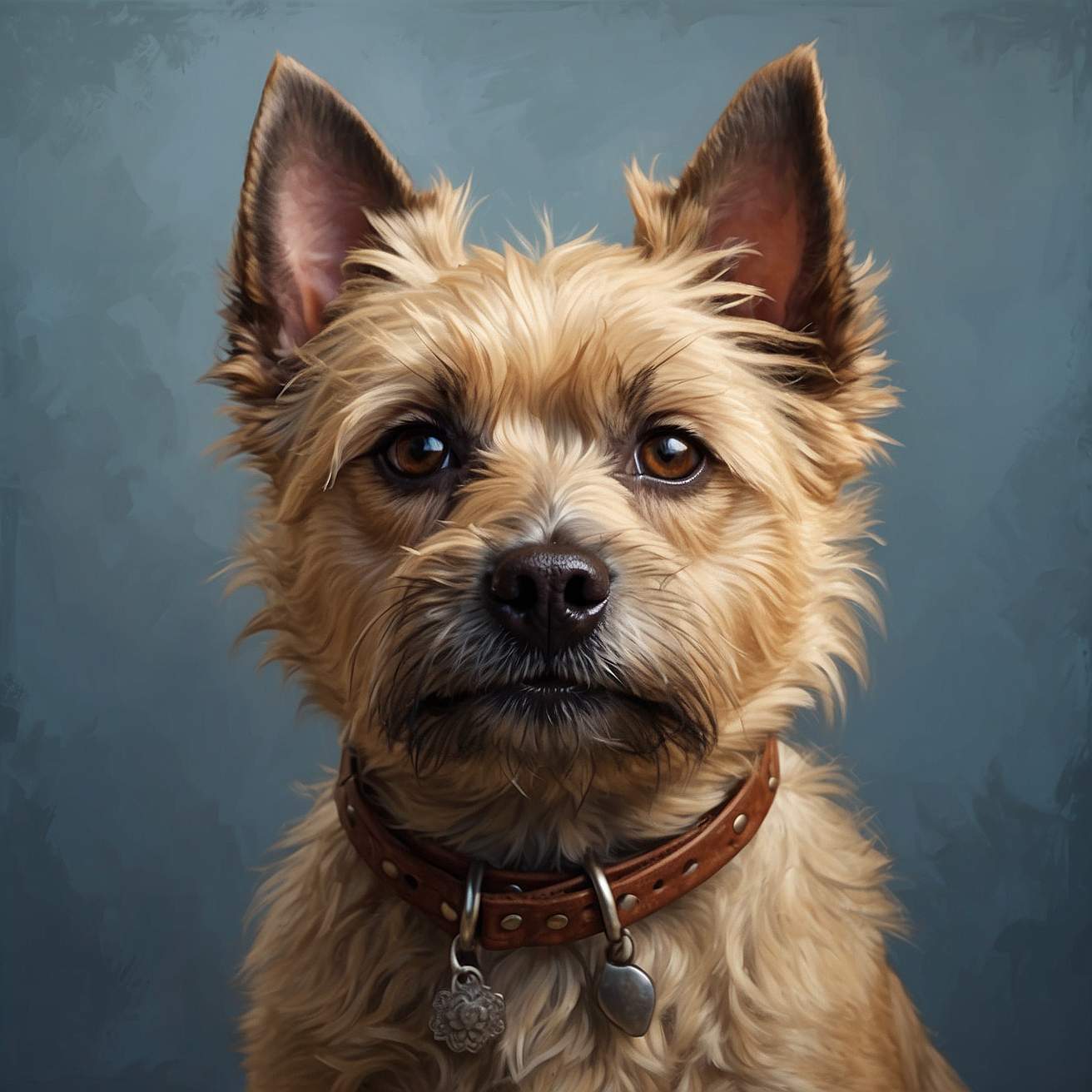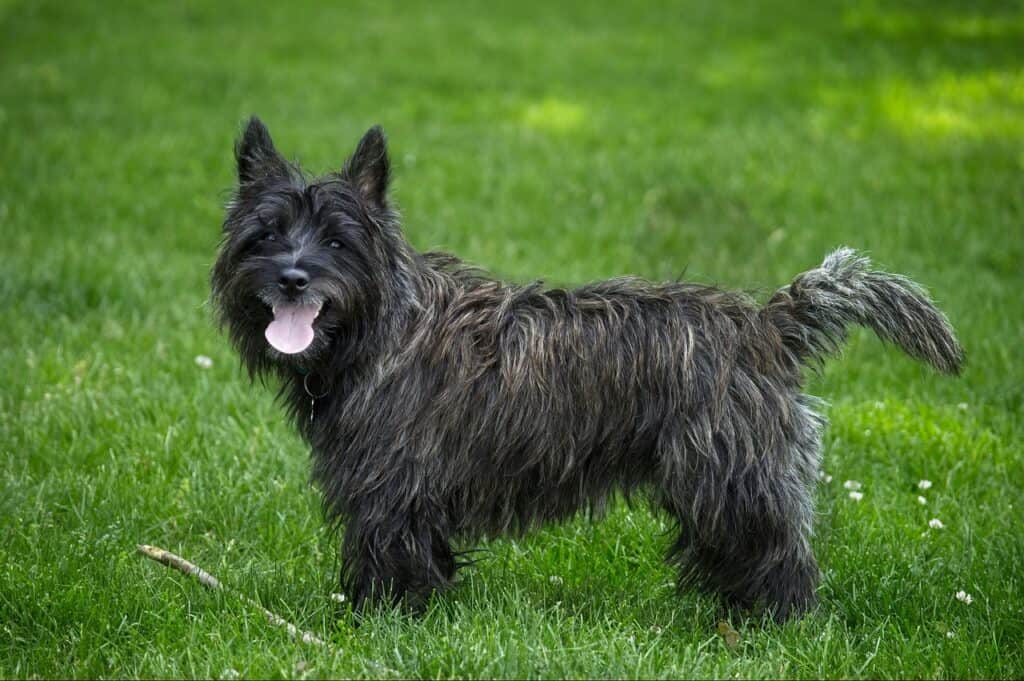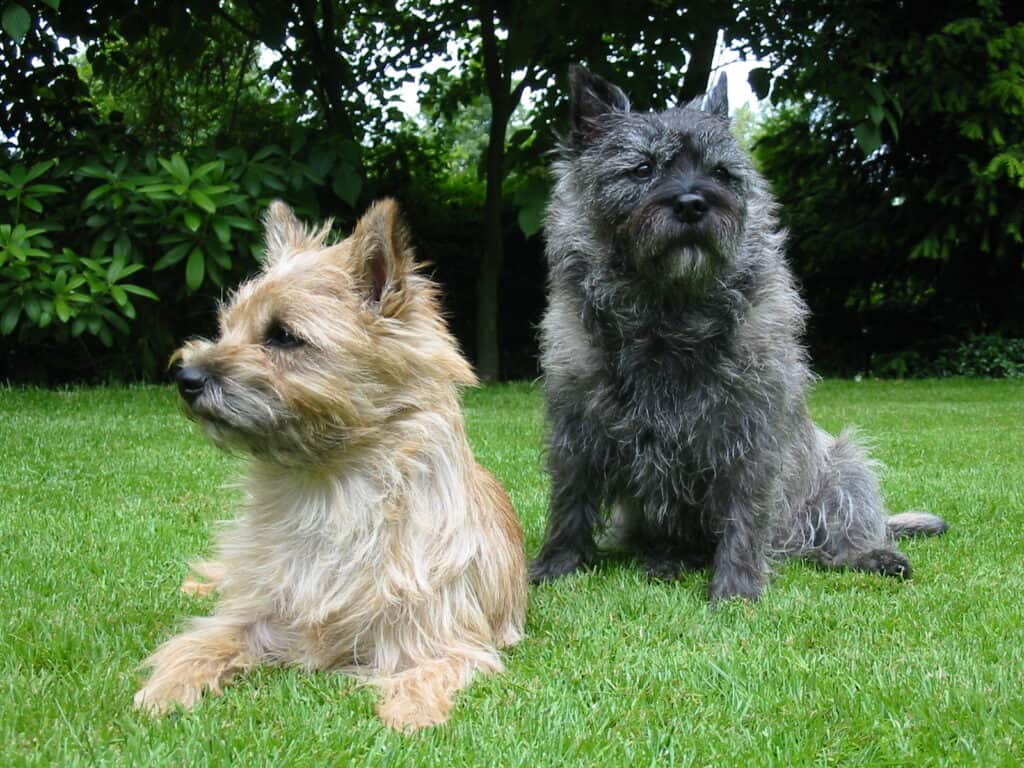Cairn Terriers, famous for their role as Toto in The Wizard of Oz, are spirited and lively companions. Discover their history, their unique care requirements, and the lovable characteristics that have endeared Cairn Terriers to dog lovers worldwide.

| Category (Explanation) | Breed Information |
|---|---|
| Year of Breed Conception | Ancient |
| Country of Origin | Scotland |
| Weight (lbs & kg) (Male) | 13-18 lbs (6-8 kg) |
| Weight (lbs & kg) (Female) | 13-18 lbs (6-8 kg) |
| Coat Type | Harsh outer coat, soft undercoat |
| Color Variations | Wheaten, brindle, red, grey, black, and cream |
| Shedding Level (Low, Moderate, High) | Low |
| Height (cm & in) | 9-13 inches (23-33 cm) |
| Breed Size | Small |
| Trainability (Low, Moderate, High) | Moderate |
| Mental Needs (Low, Moderate, High) | Moderate |
| Intelligence Level (Low, Moderate, High) | High |
| Energy Level (Low, Moderate, High) | Moderate |
| Agility (Low, Moderate, High) | Moderate |
| Loyalty (Low, Moderate, High) | High |
| Playfulness (Low, Moderate, High) | High |
| Exercise Needs | Regular exercise and playtime |
| Guarding Proficiency (Low, Moderate, High) | Moderate |
| Sociability with Children (Low, Moderate, High) | High |
| Barking Level (Low, Moderate, High) | Moderate |
| Digging Tendency (Low, Moderate, High) | Moderate |
| Destructive Behavior (Low, Moderate, High) | Low |
| Drooling Level (Low, Moderate, High) | Low |
| Obedience Level (Low, Moderate, High) | Moderate |
| Apartment Friendly (Yes/No) | Yes |
| Inherent Prey Drive | Moderate |
| Physical Risk to Others (Low, Moderate, High) | Low |
| Travel Fatality Risk (Low, Moderate, High) | Low |
| Allergen Potential | Low |
| Health Concerns (List of Common Health Concerns) | Patellar Luxation, Hip Dysplasia, Cataracts |
| Average Life Expectancy (Life Expectancy in Years) | 12-15 years |
Woof Mastery is reader supported and our articles may contain affiliate links.
Instead of running third party ads that we have no control of we only use links from high-quality companies we are directly partnered with. Making use of these links come at no cost to you our reader, and in many cases have the extra benefit of discounted rates or sign up bonuses.
If you’re interested you can read more about our affiliate policy here.
We appreciate your support and always insure that the products and services we recommend are high-quality, helpful and relevant to the subject at hand!
Cairn Terriers, famous for their role as Toto in The Wizard of Oz, have a spirited and lively history. Originating in Scotland, they were bred to hunt small game, including foxes and otters. Their name, Cairn, refers to the piles of stones used to mark burial sites in the Scottish Highlands. Cairn Terriers’ spirited and affectionate nature has made them popular companions for families. Their lively and endearing traits continue to make them beloved pets, even outside of the cinematic world.

Cairn Terriers, famous for their role as Toto in The Wizard of Oz, are special for their spirited and lively companionship. Their lively and spirited nature, combined with a rich history, makes them a delightful breed. Discover their history, their unique care requirements, and the lovable characteristics that have endeared Cairn Terriers to dog lovers worldwide. Their unique role in pop culture and their special charm make them beloved pets.
Cairn Terriers have a traditional role rooted in their spirited and lively nature. Originally hailing from the Scottish Highlands, these dogs were used for hunting small game, including foxes and badgers. Their primary role was to locate and flush out game from rocky cairns and dens, hence their name. Their fearless and spirited character made them well-suited for this task. While their historical role as hunters is not as prominent today, Cairn Terriers continue to bring their lively and affectionate traits to households as cherished family pets.
Cairn Terriers have spirited and lovable personalities. They are known for their lively and spirited nature. These terriers are affectionate and make great family pets. They are confident and require training and socialization to bring out their best qualities as loving and endearing companions.
Cairn Terriers are spirited and lovable companions. They have a history as working dogs and may exhibit a strong prey drive. While they are generally affectionate, they may not tolerate rough handling, particularly from young children. Training and socialization can help them develop into well-adjusted pets. Their lively characteristics make them enjoyable family members.
Cairn Terriers are small, lively dogs with a shaggy, weather-resistant double coat that comes in shades of red, brindle, or wheaten. They have a compact and well-proportioned body with a strong, bushy tail. Cairn Terriers have a broad head with dark eyes, small ears that stand erect, and a distinctive beard. Their legs are short and sturdy, and they have a lively and spirited gait. Cairns are known for their lovable and feisty personalities.
Cairn Terriers have a rough, weather-resistant coat that can come in various colors. Common coat colors include wheaten, brindle, red, or grey. They may have darker or lighter shadings, giving them a rustic appearance. The variation in coat colors adds to the charm and uniqueness of Cairn Terriers.
Cairn Terriers have a shaggy double coat that usually comes in a variety of colors, including brindle, black, cream, wheaten, red, and gray. Their coat can have different shades and markings, adding to their charming appearance.
Cairn Terriers have a low shedding level. They have a double coat with a wiry outer layer and a soft undercoat. Regular grooming, including brushing, helps manage shedding and maintains the coat’s texture. While they shed minimally, attention to their grooming needs and occasional grooming sessions contribute to reduced shedding. Overall, Cairn Terriers are considered to be a breed with low maintenance in terms of shedding.
Cairn Terriers have a weather-resistant double coat that requires regular grooming. Grooming habits for Cairn Terriers include:
Cairn Terriers have a moderate to high activity level. As a terrier breed, they are lively, alert, and enjoy various activities. Daily walks, playtime, and interactive games are important for their physical and mental well-being. Cairn Terriers may also engage well in canine sports such as agility. While they are not excessively hyperactive, regular exercise is crucial to prevent boredom and maintain good health. Tailor their activities to their age and individual preferences, ensuring a balance between physical and mental stimulation for a happy Cairn Terrier.
Cairn Terriers are intelligent and independent dogs. They are quick learners and respond well to positive reinforcement training. Cairn Terriers thrive on mental stimulation and enjoy engaging with their owners in play and training sessions. Their intelligence, coupled with a spirited nature, makes them adaptable to various tasks. While they may have an independent streak, their trainability and intelligence make them well-suited for activities that involve problem-solving and interaction.
Cairn Terriers have moderate mental needs. Keep them mentally stimulated with activities like puzzle toys, interactive games, and short training sessions. Regular social interaction is important, as they enjoy companionship. Provide a variety of toys and activities to prevent boredom, and consider introducing them to new environments and experiences. Engaging them in playful activities contributes to their mental well-being.
Enter The Woof Mastery

Before bringing a Cairn Terrier into your home, it’s crucial to understand their characteristics and needs. These dogs are known for their intelligence, energy, and spirited nature. Regular mental and physical stimulation is essential to keep them happy and prevent boredom. Training and socialization should start early to ensure they grow into well-mannered companions. Cairn Terriers thrive in an active family environment. Potential owners should be prepared for grooming needs and committed to providing a loving, stimulating home for these intelligent and lively dogs.
Cairn Terriers, with their friendly and spirited nature, generally pose a low risk to others. Proper socialization and training contribute to positive interactions. Responsible ownership, understanding individual temperament, and adherence to local regulations play crucial roles in ensuring a well-behaved Cairn Terrier.
Cairn Terriers are known for their friendly and outgoing nature. They can be good with children, but as with any dog, interactions should be supervised. Early socialization and positive reinforcement training contribute to a positive relationship. Teaching children how to approach and handle the dog is important.
Cairn Terriers may have mixed responses to water. Some individuals may enjoy swimming, while others may not be as comfortable. Introduce them to water gradually and observe their comfort level. Always prioritize safety and use a canine life vest if needed, especially in situations where they may be at risk of fatigue.
Early training and positive reinforcement contribute to a well-behaved and happy Cairn Terrier as they mature.
Cairn Terriers are known for being alert and may bark to alert their owners or express themselves. While they can be vocal, excessive barking is not a common trait. Early training and socialization play a crucial role in managing their barking tendencies and teaching them appropriate times to vocalize.
Cairn Terriers are adaptable and can thrive in different living conditions. They do well in homes with yards for play, but they can also adapt to apartment living if exercised regularly. Regular walks and mental stimulation contribute to their well-being. Cairn Terriers enjoy socializing with their family and thrive on attention. Early training and socialization help in preventing behavioral issues.
Cairn Terriers are generally adaptable to travel conditions. Ensure they are securely restrained in the vehicle using a crate or a suitable seatbelt harness. Monitor for signs of stress or discomfort and provide breaks for exercise. Familiar items and positive reinforcement can contribute to a positive travel experience for Cairn Terriers. Plan for regular breaks during long journeys to ensure their well-being.
Cairn Terriers may be prone to certain health issues. While not all individuals will experience these problems, it’s essential for Cairn Terrier owners to be aware of potential health concerns and collaborate with veterinarians to maintain their pets’ well-being. Common health risks in Cairn Terriers include:
Regular veterinary check-ups, a nutritious diet, proper exercise, and responsible breeding practices can contribute to the well-being of Cairn Terriers. Owners should be proactive in monitoring their pets’ health and seeking veterinary attention if any concerns arise.
Proper nutrition is crucial for the health and well-being of Cairn Terriers. Here are some nutritional habits and best practices to consider for this breed:
Breed-Specific Laws (BSL): Cairn Terriers may be subject to breed-specific laws (BSL) in certain areas. These laws are often enacted at the local or municipal level and can vary widely from one jurisdiction to another.
Types of Restrictions: The specific restrictions imposed on Cairn Terriers under BSL can include mandatory spaying/neutering, special licensing, liability insurance requirements, muzzling in public, and, in some cases, bans on ownership. The severity of these restrictions depends on local regulations.
Rationale for BSL: BSL is typically implemented based on concerns about public safety and perceived risks associated with specific breeds, often due to incidents involving dog attacks. While Cairn Terriers are not inherently aggressive, they can be affected by BSL due to their physical resemblance to breeds that are sometimes included in these laws.
Controversy: It’s important to note that BSL is a controversial topic. Critics argue that it unfairly targets breeds rather than addressing individual dog behavior and that responsible ownership and training should be emphasized instead of breed-specific restrictions.
Local Regulations: To determine if there are breed-specific laws or restrictions regarding Cairn Terriers in your area, you should check with your local animal control or government authorities. Be aware of and comply with any local regulations to ensure that you are in compliance with the law while owning a Cairn Terrier.
Woof Mastery is reader supported and our articles may contain affiliate links.
Instead of running third party ads that we have no control of we only use links from high-quality companies we are directly partnered with. Making use of these links come at no cost to you our reader, and in many cases have the extra benefit of discounted rates or sign up bonuses.
If you’re interested you can read more about our affiliate policy here.
We appreciate your support and always insure that the products and services we recommend are high-quality, helpful and relevant to the subject at hand!
Myth 1: Cairn Terriers are high-maintenance in terms of grooming.
Truth: While Cairn Terriers have a double coat, they are relatively low-maintenance. Regular brushing and occasional stripping help keep their coat healthy. They do not shed excessively.
Myth 2: They are aggressive towards other dogs.
Truth: Cairn Terriers can be social with other dogs when properly introduced. Early socialization plays a crucial role in their behavior towards other animals.
Myth 3: Cairn Terriers are not suitable for families.
Truth: Cairn Terriers are known for their friendly and affectionate nature. They can make excellent family pets, especially with proper training and socialization.
Myth 4: Cairn Terriers are hyperactive and require constant exercise.
Truth: While Cairn Terriers enjoy playtime, they do not have excessive energy levels. Moderate exercise, such as daily walks and interactive play, is generally sufficient for their well-being.
Myth 5: Cairn Terriers are difficult to train.
Truth: Cairn Terriers are intelligent and can learn commands quickly. Positive reinforcement and consistency are effective training methods with this breed.
These myths highlight the importance of understanding the specific traits and needs of Cairn Terriers for responsible ownership.
Famous Cairn Terrier owners include:
The Cairn Terrier holds cultural significance in various contexts:
The Cairn Terrier, famous for its role as Toto in The Wizard of Oz, gained widespread recognition in the 20th century. While the character Toto was played by several Cairn Terriers, the breed became iconic through its association with the film.
Cairn Terriers, like many breeds, have faced challenges over the years. Some notable challenges include:
The Cairn Terrier is a small terrier breed that originated in Scotland. It is believed to have been developed from a combination of terrier breeds, including:
Cairn Terriers, with their spirited and friendly nature, make delightful family companions. Known for their loyalty and adaptability, they seamlessly integrate into various living conditions. Their moderate grooming needs and manageable size make them suitable for families. Cairn Terriers excel in activities and training, showcasing their agility and enthusiasm. Their affectionate disposition and compatibility with children make them valued additions to households seeking a playful and devoted companion.